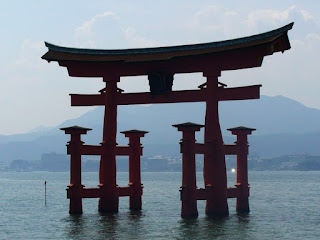We finally reached Hiroshima on Tuesday evening just as a large orange sun was setting over the city’s many hills. This seemed quite fitting, as the day before we’d witnessed an identical sunrise while leaving Prague. I’d found our hotel – the Rihga Royal - on the Internet, using Expedia. It was right in the centre of town and overlooked a traditional Samurai castle, surrounded by parklands and a large moat. The Lonely Planet guide recommended asking for a room with a castle view, which I duly did.
I’ve mentioned air-conditioning for a reason. Japan was unbelievably hot and humid the entire time we were there. Each time we walked outside, we found ourselves drenched in sweat within minutes and remained damp until we returned. Aircon was a blessing wherever we could find it. Carp fans are hardy people. Throughout the game, an endless blur of hand fans around the grounds was constantly on the move as the spectators struggled to stay cool.
The next morning, after a leisurely lie-in, we made our way to the nearby Peace Park. Just before we entered the park I took Garry down a quiet side street to a little-known plaque. It’s not marked on most tourist maps so few people visit. On the side of this quiet laneway, next to a nondescript wall, stands a simple marble stone marking the epicentre of the world’s first atomic bomb used in warfare. It’s a truly surreal experience. It’s hard to imagine that 61 years ago, standing in this spot meant instant death as a fireball hotter than the sun itself exploded 600 metres overhead.
From here we crossed the T-shaped Aioi Bridge to Peace Park (Heiwa-kōen). The distinctive shape of the bridge was used to target the atomic bomb’s release. Incredibly, the bridge survived the blast, even though the bomb’s pressure waves bounced off the river below, throwing the bridge’s deck high into the air. A short walk takes you into the park, past the Peace Bell, the poignant Children’s Peace Memorial and the Korean A-Bomb Memorial.
The Children’s Memorial is surrounded by thousands of colourful paper cranes, folded by children nationwide. Unfortunately, protesting students set fire to the cranes several years ago, resulting in them now being locked behind grubby, glass cases. When I first visited this site eight years ago, strings of cranes lay across stones and nearby trees, making for a far more emotive scene.
South of these memorials is an eternal flame and the Peace Memorial Museum. The Museum chronicles the story of the bomb’s creation, the selection of Hiroshima as its first wartime target and documents the suffering that followed its detonation. It’s a moving exhibit, especially the melted children’s lunch boxes and the shadows of people etched into stone by the bomb’s radiation waves.
We left the park mid-afternoon and caught a tram to Miyajima, one of Japan’s most photographed attractions. This sacred island is about 45 minutes south of the city by tram. It’s famous for its giant red, ‘floating’ torii (Shinto shrine gate). This gate sits in the water framing the nearby Itsukushima-Jinja shrine. In early times, the island was considered so sacred that people were not permitted to walk it. This meant that the shrine itself was built on piers over the water and was entered by passing through its floating gate.
We were in luck. It was high tide when we reached Miyajima. For most of the day, the shrine and gate is surrounded by mud flats rather than the sea. A short ferry ride (on the rail ferry of course – it's free with our pass) takes you to the island. A brief, ten-minute walk along the shore takes you to the Shrine itself. You have to dodge the friendly deer as you go. They’ll eat a tourist map if you turn your head for more than a moment, as I discovered to my detriment.
Dozens of photo opportunities later, we made our way from the shrine, up to Senjō-kaku, built in 1587. This huge, atmospheric hall is constructed from truly enormous tree logs that form its pillars and beams. Next to the hall is a brightly painted orange, five-storey pagoda dating from 1407. It’s one of only five such pagodas in Japan. Its roof, sitting above the tree tops, makes for a classic Japanese postcard photo.
From Miyajima, we made our way by train to Iwakuni. The major attraction in this town is the five-arched wooden Kintai-kyō bridge, built in classic Japanese style. The original bridge was built in 1673, but washed away during a flood in the 1950s. It was subsequently rebuilt. In feudal times only the local samurai were permitted to use the bridge. The local villagers had crossed the river by boat. Today anyone with a spare 300 yen can walk across it.
As the sun began to set, we made our way back to Hiroshima. Our rail pass, once again, making the return journey a breeze. I then took Garry to Okonomi-mura, a building consisting of 30 micro-restaurants that specialise in Okonomiyaki (Hiroshima style). This is one of my favourite Japanese dishes – one that’s hard to find outside Japan.
Read on for more about our time in Himeji and Kyoto.



























No comments:
Post a Comment